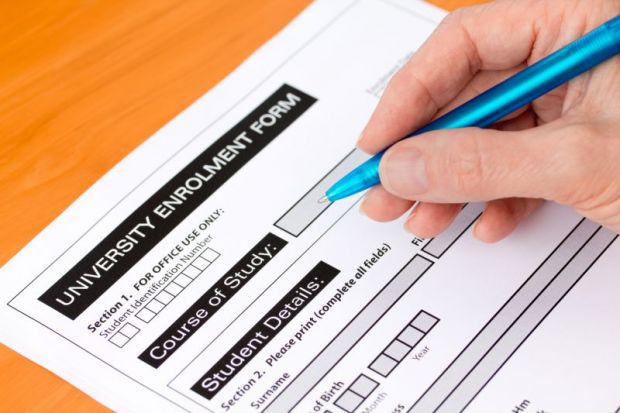The number of people applying to study at UK universities has risen for the first time in three years but less selective institutions have continued to suffer a downturn in applications, according to new data.
A total of 561,420 people applied by the main 15 January deadline, up by 2,500 or 0.4 per cent, on the previous year and the first rise since 2016.
However, applicant numbers are still lower than in 2017 when 564,190 applied by the January deadline, and only the most selective universities saw an increase in applications this year.
According to data from Ucas, higher-tariff universities had a 3 per cent uplift in applications compared with a 1 per cent fall for medium-tariff providers and a 2 per cent drop for lower-tariff institutions. For UK applicants only, the number of applications to lower-tariff universities dropped 3 per cent.
The overall rise in applicant numbers appears to have been driven by the share of English 18-year-olds who apply reaching a record high, helping to counteract the effect on applications of a declining youth population.
In England, 38.8 per cent of the 18-year-old population applied, a 1.4 percentage point increase on last year. It meant the number of English applicants fell by less than 1,000 despite a fall in the 18-year-old population of 1.8 per cent.
For the UK as a whole, applicant numbers were down 0.7 per cent, with the biggest percentage drop in applicants being those from Northern Ireland (down 4 per cent), followed by Scotland (down 3 per cent), Wales (down 1 per cent) and then England (down 0.2 per cent).
Clare Marchant, the Ucas chief executive, said that the “unexpected rise” in the application rate for English 18-year-olds “signals they still recognise the challenge and rewards of full-time undergraduate study.
“However, interest in our apprenticeships hub and our insight research shows that almost a quarter of this age group are also considering an apprenticeship at the same time, and we can expect students to keep their options open.”
There was also a large increase in the number of people applying through Ucas from outside the European Union of 9 per cent to almost 64,000, which, although making up a small proportion of overall applicants, also helped to boost the figures.
Numbers from China, which made up about a quarter of non-EU applicants, rose a third, meaning that there now almost as many people applying for full-time undergraduate courses from the country as from Northern Ireland or Wales.
Applicant numbers from the EU also rose, by 1 per cent, although they only went up for universities based in England.
Elsewhere, there was better news for modern languages as the number of applicants applying for European language and literature courses rose 1.5 per cent after declining every year since 2010. Subjects allied to medicine, which have also been hit in recent years due to changes to funding for nursing students, have also bounced back, by 5 per cent.
The subject area to see the biggest fall in applicant numbers was mass communication and documentation (courses such as media studies and journalism) which fell 11 per cent, followed by mathematical sciences (down 10 per cent). The biggest increase was in medicine and dentistry (up 7.6 per cent).
Meanwhile, the gap between those applying from the most advantaged and disadvantaged neighbourhoods narrowed slightly. The share of 18-year-olds applying from the most advantaged neighbourhoods rose 1 percentage point to 53.5 per cent compared with an increase for the least advantaged areas of 1.3 percentage points to 23.2 per cent.
The difference between applicant rates in London and other English regions appears to have widened, though. Half of London-based school leavers now apply to university and they are now 36 per cent more likely than 18-year-olds in the rest of England to have applied to higher education (up from 33 per cent more likely last year).
Find out more about THE DataPoints
THE DataPoints is designed with the forward-looking and growth-minded institution in view
Register to continue
Why register?
- Registration is free and only takes a moment
- Once registered, you can read 3 articles a month
- Sign up for our newsletter
Subscribe
Or subscribe for unlimited access to:
- Unlimited access to news, views, insights & reviews
- Digital editions
- Digital access to THE’s university and college rankings analysis
Already registered or a current subscriber? Login








